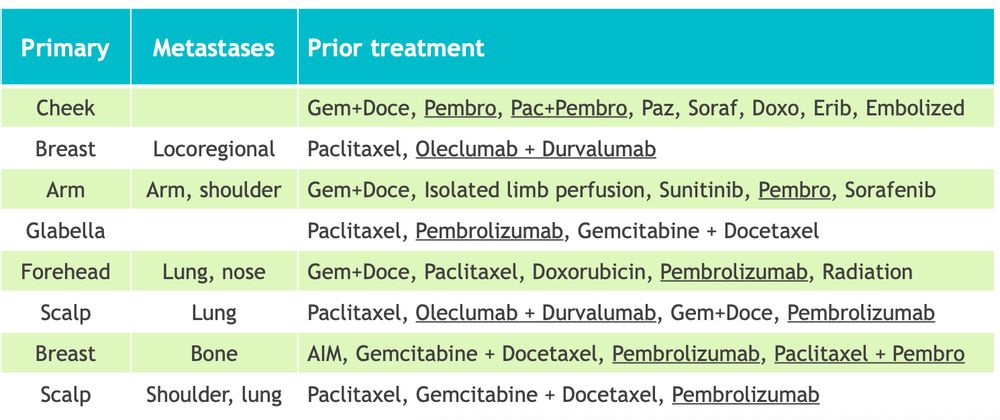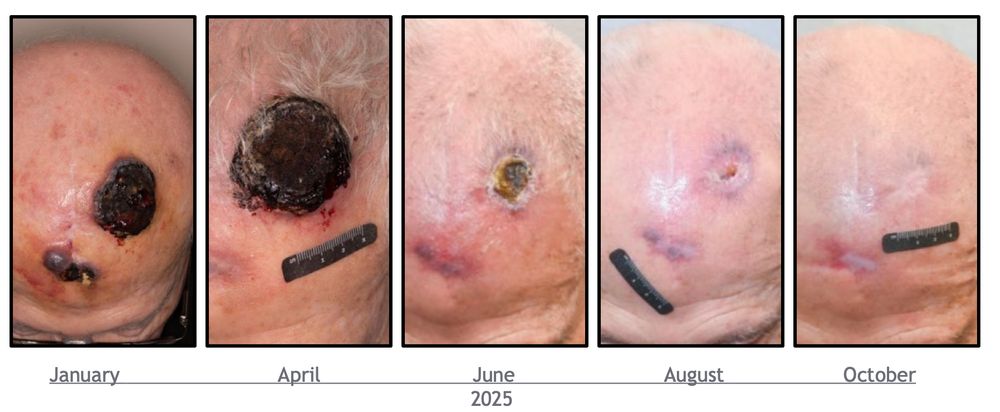
(At age 55 for those numbers). Full paper from Southern Community Cohort Study here: jamanetwork.com/journals/jam...
25.11.2025 20:41 — 👍 1 🔁 0 💬 0 📌 0@hannahrabrams.bsky.social
Heme/Onc fellow at Fred Hutch, hoping to reduce costs & improve patient/caregiver experiences in cancer care. Social Media Editor @ JCO OP. Views are my own. #MedSky

(At age 55 for those numbers). Full paper from Southern Community Cohort Study here: jamanetwork.com/journals/jam...
25.11.2025 20:41 — 👍 1 🔁 0 💬 0 📌 0Important aspect of recent lung cancer screening discussion prompted by the new JAMA Open article: even if we were to keep pack-year criteria, current cutoffs are inadequate & disproportionately rule-out Black patients.
From 2019 analysis: ~30% sensitivity, 80% specificity
Sorry @erictopol.bsky.social it doesn't. All participants were normal coffee drinkers. Therefore, the coffee-drinker arm is the Control arm. The intervention of going cold turkey increased the hazard of AF by 64% (100/0.61). The whole report is written from the wrong perspective.
10.11.2025 00:02 — 👍 59 🔁 9 💬 6 📌 3When patients with metastatic cancer are admitted to the hospital, many people optimistically say "you'll go to rehab and get stronger and we'll see you back!"
IMO this data suggests we need 1) better care coord with SNF & 2) more honest discussion of what outcomes may be after.

Of patients who did restart treatment, 39% died or transitioned to hospice before next scan.
More from the publication here:
ascopubs.org/doi/10.1200/...

Highlighted passage: Included in this study were patients with biopsy-confirmed mNSCLC who had not yet progressed or experienced serious adverse events to single-agent chemotherapy, and thus had reasonable options for further palliative systemic therapy. Patients must have been discharged to a SNF with an intention for further therapy once functional status permitted.

Fig 1. Sankey diagram depicting planned systemic therapy, proportion of patients who received said therapy, and treatment response. Chemo, any chemotherapy containing regimen; ICI, immune checkpoint inhibitor; TKI, tyrosine kinase inhibitor. Of the total 427 patients, 173 (40.5%) had a hospital readmission within the subsequent 30 days after discharge to a SNF. Only 229 (53.6%) ever managed to return to an outpatient oncology visit, and only 131 (30.7%) received any subsequent systemic therapy. This proportion varied by the intended therapy (Fig 1; Table 2), with 40 of the 54 planned for a TKI (74.1%), 42 of the 130 planned for ICI (32.3%), and 49 of the 243 planned for cytotoxic chemotherapy (20.2%) receiving further therapy (P < .001).
Wow. Data from @n8pennell.bsky.social & team #JCOOP confirming the care fragmentation many of us see in real life.
Patients with metastatic NSCLC whose docs felt it was reasonable for them to restart treatment after rehabbing at a SNF:
- Only 54% saw outpt onc again
- 31% restarted tx
So sorry to hear that - and in some ways so frustrating that this limited time is being filled up with mychart admin tasks. Wishing the best for you both.
21.11.2025 04:48 — 👍 1 🔁 0 💬 1 📌 0
TABLE 1. Examples of Noncompliant Statements on the Basis of Individual Clauses of the ASCO Language of Respect Guidelines, Along With Suggested Compliant Versions Clause Noncompliant Compliant Do not blame the patients XX were screen failures XX were not eligible for the study Patient responded to... Patient had/experienced response to Responders/nonresponders Patients with response/no response Progressors Patients who had progressive disease Patients failed to respond to... Patients who did not have response to.... Patients achieved response Patient had/experienced response Patients are resistant to treatment| Patients who had progression on treatment Noncompliant patients Patients with barriers to adherence High-risk patients Patients with high-risk disease Respect role of the patients Patients managed with immunotherapy Patients had clear cell histology Patients treated with immunotherapy Do not dehumanize the patients Patients with clear cell RCC XX% were IMDC high risk XX% had IMDC high-risk disease Patients were classified as polymetastatic Patients were classified as having polymetastatic disease PD-L1-negative/PD-L1 -positive patients Patients with PD-L1-negative/PD-L1-positive disease Cases, subjects, controls Participants RCC patients Patients with RCC irAE patients Patients with irAE Patients were staged with MRI Disease staging was performed via MRI Immunotherapy users Patients on immunotherapy Patients treated with immunotherapy Smokers Patients who smoke XX mutants, wild types Patients with XX-mutated/wild-type disease Stage Ill patients Patients with stage Ill disease
"our report highlights the need for our professional societies and abstract reviewers to cultivate greater awareness and adherence to patient-respectful language"
Original research from @narjustflorezmd.bsky.social @jco-asco.bsky.social @ascocancer.bsky.social
ascopubs.org/doi/10.1200/...
I wish we could unify mycharts across sites the way it is now connected on the provider end! Also hate that this is happening to you, @publichealthguy1.bsky.social
20.11.2025 04:40 — 👍 2 🔁 0 💬 1 📌 0free study idea! i’ve found myself avoiding the mychart app this year because it immediately showers me with notices about my medical debt, including when i try to schedule appointments. can’t help but wonder whether this is adversely affecting care and/or outcomes for vulnerable patients
19.11.2025 17:14 — 👍 52 🔁 12 💬 5 📌 0
Woah! 41% of stage I/IIA dMMR colon cancers could be overstaged by CT imaging. May need better ways to upfront stage (MRI, ctDNA?) in the neoadjuvant ICI era. #GIOnc #OncSky #MedSky #JCOOP
ascopubs.org/doi/10.1200/...
We also need to know *which* subsidies are in play. As I understand it:
Paragon has proposed converting CSRs to HSA contributions
Cassidy has proposed converting ePTCs to HSA contributions
Trump has proposed (I think? this is least clear) converting *all* subsidies to HSA contributions.
If you or your caregiver are working at time of cancer diagnosis, it almost seems unfathomable how people can make it financially work. Often “good” insurance doesn’t correlate with coverage, and while there are some good support programs out there it can be a full time job in itself to set up.
19.11.2025 14:47 — 👍 8 🔁 2 💬 0 📌 0Notably among ideas:
1. Capping extra $ paid for convenience &
2. Postmarketing review re: whether actually more convenient.
3. Clear eye to not allowing convenience to result in patent ever greening
Article here:
ascopubs.org/doi/10.1200/...
Original here:
ascopubs.org/doi/10.1200/...


In Sept, Bishal Gyawali published in #JCOOP on the high cost of some 'more convenient' Rx formulations (peg-GCSF, oral GNRH instead of SQ/IM, combo pills)
Out now, European perspective on how to operationalize this:
ascopubs.org/doi/10.1200/...
Can’t wait to see more people there! @tonybreu.bsky.social & @avrahamcoopermd.bsky.social are already figuring out tweetorials :)
19.11.2025 03:43 — 👍 1 🔁 0 💬 0 📌 0Yeah, I think you do need an algorithm to get some serendipity/hear people you wouldn't otherwise have followed. But weighting it to paid subscribers gets rid of that benefit. Hoping that Roon can find the right balance with it because it's run by former medtwitter fans
18.11.2025 16:23 — 👍 1 🔁 0 💬 0 📌 0The people who pay for X subscription get amplified, so it feels like my feed has fewer people in it because only the people paying come to the top.
It's a shame because my favorite part of #medtwitter was hearing from a wide range of people including students/trainees

I have gone back in a limited way recently as part of a journal role. It is still alive but definitely different subjects and tone, & paid-subscriber amplification means hearing from fewer. Looking into alternatives - Roon is between Twitter/Linkedin and launching now www.roon.com/doctors/home
18.11.2025 15:56 — 👍 4 🔁 2 💬 2 📌 0
I often hear "I wish we didn't have to waste these expensive meds every time a patient stops & has extra left over."
Here's what the state of Michigan did to combat this:
- Statewide cancer drug repository, 105 sites
- $26 million value/>100K pills donated to >1K pts
ascopubs.org/doi/10.1200/...

Scientist at lectern with slide reading "Q&A"

Conclusion slide: • Intact IGF1/PPARG2 in WDLPS • PPARG2 restores differentiation in DDLPS GLP1 signaling is the dominant, druggable epigenetic program in DDLPS Induces increased expression of adipose markers Identifying chromatin modifiers at the PPARG2 TSS Fully characterizing GLP1-induced differentiation and other cellular processes modified through this axis
Exciting end to #CTOS2025 with final presentation from Erica Pimenta. Could PPARγ-2 or GLP1 agonists restore differentiation in dedifferentiated liposarcoma?
15.11.2025 21:43 — 👍 5 🔁 1 💬 0 📌 0


Can adding aromatase inhibitor (+/-LHRHa) rescue patients with #PEComa who progress after responding to mTOR inhibitor? #CTOS2025
- n=23 women
- 26% PR, 35% SD
- Time to progression generally shorter than initial mTORi response
- Some exceptions in patients with TSC1/TSC2/PTEN

Man at lectern smiling

ChonDRAgon study design. Patients allowed to crossover to ozekibart at progression

KM curve with PFS at 12 mo of 21.7%

Tornado plot of TRAE with fatigue, diarrhea, nausea, and elevated LFTs highest
.@RobinL_Jones @royalmarsden presenting ChonDRAgon PhII registrational study of Ozekibart in conventional #chondrosarcoma #CTOS2025.
- No approved systemic therapies
- mPFS 5.5 mo, with 21.7% w/o prog @ 12 mo
- Activity in both IDH-WT & mut
- TRAE incl ~13% fatigue, ~6% hepatitis

List of sites and prior treatment lines for patients enrolled. All patients had received both chemotherapy and checkpoint inhibition.

Receding scalp lesion shown in photographs

Multiple receding lesions shown.
#CTOS2025 Need options for pts w/ angiosarcoma who are refractory to ICI. In PhI, injected oncolytic virus w/ TGF-B trap (AdAPT-001) shows some efficacy! Notably heavily pre-tx group.
13.11.2025 20:01 — 👍 1 🔁 0 💬 0 📌 0
Waterfall plot of response rate with lete-cell in SS/MRCLS with 43% ORR

Paired waterfall plot and KM curves of afami-cel and lete-cel
More data on TCRs in synovial sarcoma/MRCLS! In pooled analysis, Lete-cel (NY-ESO-1), w/ similar ORR to afami-cel (MAGEA4) & median OS 20.5 mo w/ small subset long-term responders.
Exciting to have multiple cell therapy options, need further studies to know how to seq & cross-sensitivity. #CTOS25

Waterfall plot of change in max lesion size among patients with TRK fusion sarcomas who had a 2+ year response
Larotrectinib for TRK-fusion sarcomas: when it works, it works.
- 38% long-term (2 year) responders
- In responders, 73% remain without progression at 6 years, 98% OS
#CTOS2025 Next questions: When to stop? How to predict responders?

A man stands at a podium in front of a slide, the top of which reads "Conclusions: there are many ways to lose your shirt"
Wisdom from #JCO assoc editor Bob Maki at #CTOS25:
“There are many ways to lose your shirt. Las Vegas, Crypto, and [bad] statistical design.”
Congratulations to @thewonkologist.bsky.social & colleagues on the publication!
12.11.2025 00:51 — 👍 0 🔁 0 💬 0 📌 0
Additionally, the government could address inadequate competition by funding comparative effectiveness studies for different drugs in the same class or mandating standard- of-care active comparators. Generating evidence that drugs could be prescribed cross-label (ie, one drug being pre- scribed for an indication for which a different within-class drug is approved) would enable more direct competition within indications.
Where to go from here?
You'll have to read the whole article in #JCO/#JCOOP, but here's a sneak preview!
Overall, supporting new ICIs & cross-label Rx may help ⬇️ price, and I think it's good there's incentive to explore new indications (incl rare cancers) w newer ICIs.
ascopubs.org/doi/10.1200/...
So why didn't the price go down?
With so many non-overlapping indications, hard to get price competition.
Authors speculate whether could be anticompetitive, though I wonder how much is because once an ICI indication is established, ethical trial w/ ICI comparator is not financially viable to do.